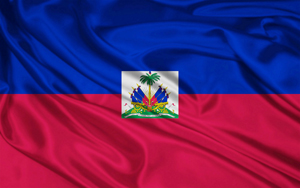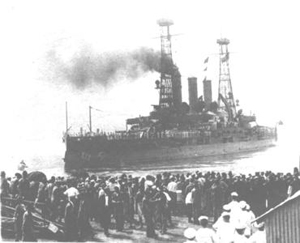HAITI : Charlemagne Peralte - Haitian Hero, ‘Supreme Bandit’ of First US Occupation (Part I)
By Dady Chery, Haiti Chery, May 18th 2012
http://www.dadychery.org/2012/05/18/charlemagne-peralte-haitian-hero-sup...
After more than a century sailing along as an independent black nation, Haiti collided with the Monroe Doctrine. This doctrine came in the form of the National City Bank of New York (Citibank) and the U.S. State Department which, together, pressured Haiti’s government to sell them 40% of the Banque National d’Haïti (BNH): Haiti’s treasury. Thus the U.S. acquired a financial interest in Haiti’s U.S. $32 M public debt and the pretext for an invasion.
Roger L. Farnham: U.S. kingmaker, Monroe doctrinaire
The architect behind the U.S. scheme to assume control of Haiti’s treasury was Roger L. Farnham, a wealthy American kingmaker and personal friend of U.S. President Woodrow Wilson. Farnham became the BNH’s new vice president after the takeover. Farnham was also the vice-president of Citibank and president of the National Railway of Haiti, two companies that had just swindled Haiti out of more $5 M to complete a national railroad, which was never done. W.R. Grace and Citibank had financed the project, which was guaranted by the Haitian government at an interest of 6% on $32,500 for each mile.
When the Haitian government refused to continue to pay the interest on the railroad project, Farnham embarked on a mission to get Haiti into a customs receivership. To coerce the government into acepting his conditions, he alternately threatened Haiti’s politicians with a direct U.S. intervention or with more personal sorts of punishments, like witholding of their salaries. Haiti’s lawmakers refused.
Despite a tumultuous political period between 1908 and 1915 that led a dizzying series of government changes, every Haitian president (six in all) rejected the Monroe Doctrine measures which came with the threat that U.S. would not grant them formal recognition. These included:
- Allowing the U.S. to collect customs duties directly to pay the debt owed to Citibank.
- Pledging not to lease Haitian territory as a coaling station or naval base to any foreign power besides the U.S.
In 1914, Farnham whisked away two strongboxes with $500,000 of Haiti’s gold to New York aboard the USS Machias, and he deposited them into the Citibank vaults. This theft of hard currency rendered Haiti completely dependent on the U.S. for its operating budget. The Haitian government protested against the U.S. intervention on behalf of its corporations — to no avail.
Farnham did not stop there. With the outbreak of World War I, he changed his rhetoric to a call for neutralization of the “threat” posed to the U.S. by the French and Germans in Haiti (who were in reality a small group of well-assimilated business people), and then he waited for the right moment for an invasion.
The opportunity came on July 27, 1915 when Haiti erupted in revolt because the president had ordered the assassination of 167 of his imprisoned political opponents. The president was dragged out by an angry mob from the French embassy and dismembered in the streets. Simultaneously with these events in Haiti, U.S. president Wilson dispatched 330 U.S. Marines to the island to “re-establish peace and order.” The Marines arrived in Port-au-Prince the next day. According to writer and historian Eduardo Galeano, after placing the city under martial law,
“the first thing [the Marines] did was take the customs and tax collection office. The occupation army retained the Haitian president’s salary until he resigned himself to sign the liquidation of the Banque Nationale d’Haiti, which became a branch of Citibank in New York.”

Soldiers marching from League Island Navy Yard, Philadelphia heading for the Connecticut, the ship which took them to Haiti.
The notion that a Black nation could not govern itself and had degenerated into chaos greatly appealed to the news writers and historians of these days of overt racism. On this point, Wilson’s Secretary of State Robert Lansing said:
“the African races are devoid of any capacity for political organization” and possess “an inherent tendency to revert to savagery and to cast aside the shackles of civilization which are irksome to their physical nature.”
Such ideas persist today in the narrative about the U.S. occupation of Haiti because they have so often been repeated. By contrast, there is scant mention of the fact that the U.S. invaded, not only Haiti, but also of Nicaragua, Mexico, Cuba, and Panama during Wilson’s 1912-1920 presidency. Wilson would go on to receive the Nobel Peace Prize in 1920 for his pacifism during WWI, although he also declared war on Germany in April 1917 and even pressured Haiti to join the U.S. in this war declaration. Again, the Haitian government refused.
Ultimately the U.S. found a pliant, cowardly Haitian in the person of Sudre Dartiguenave. The Haitian lesiglature, was physically intimidated into accepting Dartiguenave as president. A highly-placed U.S. Marine Smedley Butler wrote:
“When the National Assembly met, the Marines stood in the aisles with their bayonets until the man selected by the American Minister was made President.”
On November 11, 1915 Dartiguenave, threatened with a full military takeover from the U.S., signed a treaty:
- To permit customs receivership for 20 years, with Farnham appointed the receiver of the National Railroad of Haiti; thus Farnham took over Haiti’s entire railway system and its territorial concessions.
- To allow the appointment of a high commissioner of Haiti (General John H. Russell) to run the country alongside the Haitian president.
- To create a financial advisers’ office, public works service, and public health service, all of them headed by Wilson-designated U.S. nationals.
- Not to transfer any of Haiti’s territory to any country other than the U.S.
- To disband Haiti’s army and create the Gendarmerie d’Haiti: a US-led force of 3,000 Haitian men that answers to the U.S. Secretary of State.
The Gendarmerie soon became a group of corrupt Haitians who functioned as a source of intelligence for the U.S. and became rich from extortion and kickbacks. According to journalist Samuel G. Inman,
“[A gendarme] is the judge of practically all civil and criminal cases, the paymaster for all funds from the central government and ex-officio director of the schools inasmuch as he pays the teachers. He controls the mayor and city council since they cannot spend funds without his ok. As collector of taxes, he exercises a strong influence on all individuals in the community.”
But well before this capitulation by Haiti’s politicians, a new Haitian revolution had already started. It began on Monday, August 30, 1915, when a group of U.S. marines went to meet Charlemagne Peralte, commander of the military district in Leogane, to try to collect his flag and weapons.






